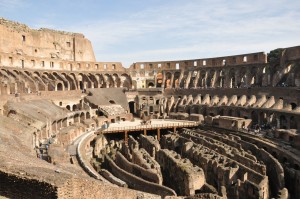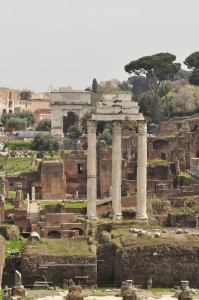It’s not quite caveat emptor but the idea is similar. Tourism is primarily—the primary?—source of income in Rome. Spontaneity, a commendable trait, is likely to exacerbate that leak in your wallet. Rome seems just as problematic as when “Bear Leaders,” those approximate experts, squired their “Cubs,” the newest arrivals, around Rome in the 18th century as the Grand Tour grew in popularity.
For instance: is the “Roma Pass” a good deal or not? It costs 34 € per person and offers free entry into the first two sites visited plus a discount on quite a few others. It also includes a public transportation pass. It’s good only for three days, though, and therein lies the rub.
Those who appear to be in the know say to use the pass to get into the most costly venues (i.e., the Museo Borghese and the Colosseum plus Roman and Palatine forums). That would work if you could actually use it to get into the Borghese. And if the Colosseum and Forae weren’t so packed with tourists.
The Pass works for the Borghese in theory but getting it to work in practice is another matter.
The Borghese requires a reservation and to make a reservation you have to pay up front—and no box you can tick for “Roma Pass.” No space was available until the eighth day of our holiday so the likelihood one can simply show up at the entrance, clutching a Roma Pass, and get in that day are slim and none.
When the big-ticket sites can’t be deducted from the cost of the pass—and since Rome is extremely walkable and a 100-minute ticket for public transportation costs only 1.50 €–it is hard to offset the cost of the Pass with low-cost venues and a lot of time on buses and the Metro.
A news item soon after our arrival on the first of April announced that there were approximately three million tourists in Rome. Most of them were elbowing us out of the way in the Colosseum and the Forae. Exploration of those locales was all but impossible and we extracted ourselves forthwith.
Accessing the Forae was its own challenge and one terribly exacerbated by the crowds. Once upon a time, one just wandered down from the Capitoline Hill or in from the Palatine. Nowadays ingress is on the Via dei Fori Imperiali, Via Sacra and Via di San Gregorio. Uscita is more of a problem; there are exits on Via Dei Fori Imperiali and Via di San Gregorio as well as through a turnstile atop the stops leading to the Capitoline. In other words, one can’t necessarily get in once arrived and out once exhausted and ready to move on.
So what do I think? For the enthusiast of classical antiquity, the Rome Archeological Card (at 27,50 €), good for seven days, is probably a good deal. And if you are going to be in Rome for at least five days, maybe the seven-day ATAC card, too. For 24 € you can ride the Metro, buses and trams to your heart’s content—especially if you plan excursions to Tivoli or Ostia Antica.
Alternatively there are seven, count’em seven, different “hop on-hop off” sightseeing buses. This seems like a fine way to get to a variety of places, some of them quite distant from the historic center. Do your homework ahead of time, though, and don’t get bullied into buying a ticket from an aggressive hawker. The Rome Toolkit site provides a lot of information and maps of the different routes.
Time wasted in lines, crowds obscuring the art you most want to see, availability of tickets: all these become part of the costs of a Roman holiday.
So as always, Tourists be careful.



